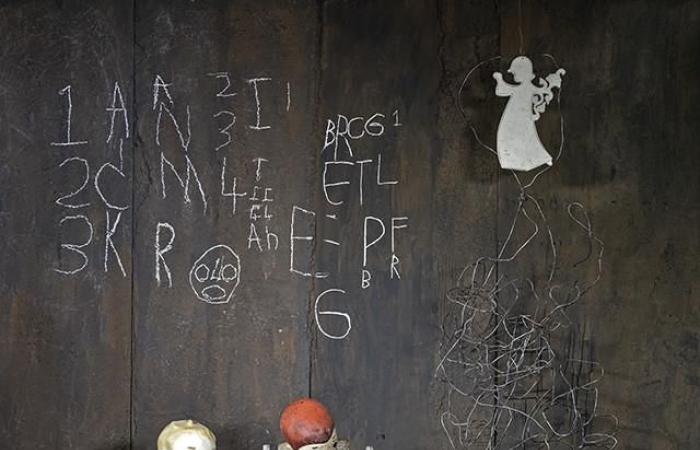Founded in 2012 in Geneva, Switzerland, the Eiger Foundation is dedicated to promoting photography as a significant art form in Africa and around the world through various initiatives, including exhibitions, educational programs, exchanges cultural, as well as prizes and scholarships.
Each year, the foundation awards the Eiger African Photography Book Prize to a photographer from Africa or working in Africa. The 2024 edition of this prize was designed in close collaboration with the Inside Out Center for The Arts based in Johannesburg, South Africa, founded in 2023 by artist and photographer Roger Ballen, with whom the Eiger Foundation recently established a partnership to strengthen its mission. The Eye of Photography interviewed Roger Ballen to learn more about this collaboration and their shared vision of the photography book as a powerful medium.
Could you tell us about the Inside Out Center for the Arts and its genesis?
The Inside Out Center for the Arts promotes art and photography related to the African continent through exhibitions and educational programs. Our goal is to provide a powerful multimedia experience, incorporating photography, video, installations, drawing and painting. The Center opened its doors to the public in mid-2022. I named it “Inside Out Centre” because it carries a psychological emphasis. Much like my own photography, the Center seeks to bring to the surface deeper elements of our subconscious, encouraging visitors to engage and explore its hidden thoughts and emotions.
I first founded the Roger Ballen Foundation in 2007, focused on the advancement of photography education in South Africa. Through the Foundation, we have sponsored exhibitions in Johannesburg featuring renowned international artists and organized lectures for students. However, I eventually realized that the Foundation needed a permanent home where exhibitions and programs could take place on an ongoing basis.
In January 2018, I purchased a property that I thought was ideally located in Johannesburg. At first I wasn’t sure whether to use it solely as an office and space to create my own photographs or establish a full-fledged exhibition venue. After thoughtful discussions with architect Joe Van Rooyen, we decided that the building should not only house my office, but also serve as a public exhibition space. We chose concrete as the main material for the building because it reflects many of the visual elements found in my own photographs. We also ensured that the space could accommodate various forms of media beyond photography, allowing for a more diverse range of artistic expressions. Construction began in 2019.
How did the collaboration with the Eiger Foundation come about?
The collaboration with the Eiger Foundation was born from our shared vision and goals to advance the art of photography. The Roger Ballen Foundation and the Eiger Foundation are committed to promoting public awareness of photography as an important and influential art form. Our work focuses on creating a deeper understanding of the aesthetics and meaning of photography, supporting aspiring and established photographers, and building a collection of photographic works.
In addition to these shared values, the collaboration naturally evolved through our mutual interest in providing educational programs. The Eiger Foundation, like ours, aims to meet educational needs by creating opportunities for learning, teaching and training in photography. Working together, we hope to develop initiatives that support photography programs in educational institutions, thereby strengthening the impact of photography as an essential tool for artistic expression and cultural understanding.
This partnership allows us to combine our resources and expertise, ensuring that our collective efforts to promote and preserve the art of photography reach a wider audience and have a lasting impact.
Why do you think the book format is so important for photography?
The book format is essential for photography because it provides a more intimate and immersive experience, allowing images to be organized and sequenced to create a cohesive narrative or evoke specific emotions. Unlike a gallery or screen, where photographs often stand alone, a book offers a tactile, multi-sensory interaction where the physicality of the flipping and the layout contribute to the overall experience. For me, as someone who values the connection between form and content, a book allows complete control over how images are presented, transforming it into a work of art in its own right. It also democratizes photography, giving people the opportunity to engage with and own works they might not encounter in a gallery, providing an accessible and sustainable way to experience photography.
Do you personally favor it as a photographer?
I really value photography publications. Having published over 20 books, I have always favored the book format as a photographer. My journey with books began in 1979 when I published my first book, Boyhood.
For me, the book format allows for a deeper and more controlled expression of my work. It provides the opportunity to carefully sequence images, creating a visual narrative that unfolds on each page. The experience of a book is deeply personal and immersive: viewers can take the time to interact with the images on their own terms. The physicality of a book, from the choice of paper to the design, adds another dimension to the work, making it a sustainable and accessible art form. Unlike exhibitions, which are temporary, books endure over time, reaching audiences across the world and allowing my photographs to exist in a form that can be revisited again and again.
More information






